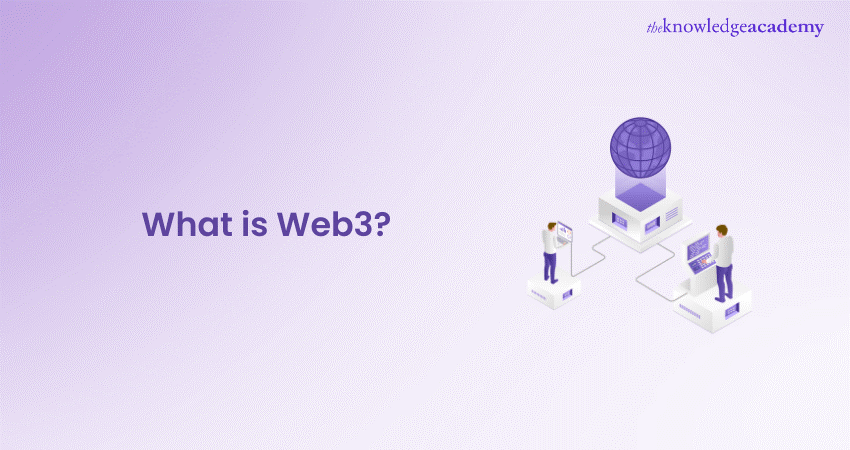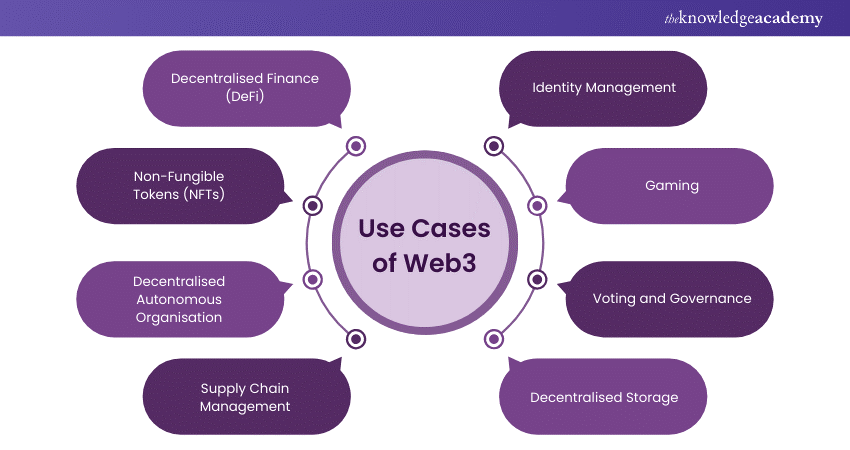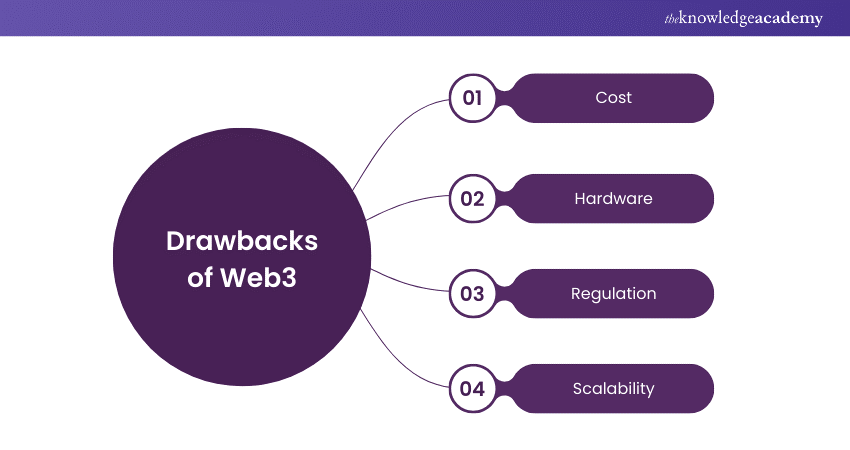We may not have the course you’re looking for. If you enquire or give us a call on 01344203999 and speak to our training experts, we may still be able to help with your training requirements.
We ensure quality, budget-alignment, and timely delivery by our expert instructors.

Have you ever wondered what the future of the internet looks like? Envision a world where you control your data and online interactions, free from centralised platforms and intermediaries. This is the promise of Web3, a revolutionary shift that aims to transform the digital landscape as we know it. But What is Web3, and how does it differ from the internet we’re familiar with?
As we delve deeper into the world of Web3, we'll explore its foundational technologies, practical applications, and the significant benefits it brings. Are you ready to unlock the future of the internet and discover what Web3 truly has to offer? Let’s dive in and explore this exciting new frontier, answering the question: What is Web3?
Table of Contents
1) What is Web3?
2) Understanding the Evolution: From Web1 to Web2
3) Importance of Web3
4) Working of Web3
5) Use Cases of Web3
6) Drawbacks of Web3
7) Technologies Behind Web3
8) How to Get into Web3?
9) Conclusion
What is Web3?
Web3 signifies the future of the internet, emphasising decentralisation, user autonomy, and heightened security using Blockchain and cryptographic innovations. Web3 uses distributed networks and Smart Contracts to empower users with ownership of data and assets, unlike Web1 and Web2. This paradigm shift aims to foster trust, transparency, and censorship resistance in digital interactions and transactions.
Web3 enables decentralisation, user autonomy, and security via Blockchain, fostering trust and innovation in digital interactions and transactions. This evolution promises greater individual control online, shaping a more democratic and resilient internet landscape.
Understanding the Evolution: From Web1 to Web2
To understand Web3, it’s essential to first grasp the concepts of Web1 and Web2. Web1, the initial version of the internet, emerged in the 1990s and early 2000s. It was primarily built on open protocols, which allowed anyone to exchange information freely. During this period, the internet was mainly used for reading web pages and chatting with friends or strangers.
As Web1 evolved, it became a platform for e-commerce and academic and scientific research. Web2 began in the mid-2000s with the rise of new internet companies like Facebook, Twitter (now X), and Wikipedia. These platforms enabled users to create their own content.
Importance of Web3
Understanding the significance of Web3 is crucial as it revolutionises the internet, empowering users with enhanced control, security, and transparency. Let's delve into why Web3 matters and how it is transforming our digital landscape.
1) Ownership
Web3 indeed revolutionises digital asset ownership through NFTs. These tokens provide verifiable ownership of digital assets on the blockchain, ensuring that items cannot be taken away by game creators or other centralised entities.
2) No Censorship
Web3 technologies offer a decentralised approach, reducing the risk of censorship and sudden policy changes that can impact creators. Platforms built on Web3 principles allow creators to maintain control over their content and revenue streams.
3) DAOs Autonomy
Decentralised Autonomous Organisations (DAOs) enable collective ownership and decision-making. Token holders can vote on proposals, and smart contracts execute decisions automatically, promoting transparency and community governance.
4) Identity
Web3 simplifies identity management with Ethereum addresses and the Ethereum Name Service (ENS). This allows for a single, secure, and censorship-resistant login across multiple platforms, enhancing user privacy and control.
5) Direct Payments
Web3’s payment systems use cryptocurrencies like ETH for direct transactions, bypassing traditional banks and payment processors. This inclusivity allows anyone with internet access to participate in the digital economy.
Transform your skills with App & Web Developer Training – start your journey today!
Working of Web3
Web3 operates on decentralised networks using Blockchain technology, highlighting the strong connection between Web3 and Blockchain in enabling a trustless and transparent digital ecosystem. Transactions are verified and recorded securely through consensus algorithms across a distributed network of computers. This decentralised approach ensures transparency and resilience against tampering, reducing reliance on centralised intermediaries.
Smart Contracts in Web3 automate agreements, enhancing efficiency and trust in digital interactions without intermediaries. This new paradigm aims to empower individuals. It grants them greater control over their data and assets, fostering a more secure and equitable internet environment. This includes enhanced privacy protections and reduced censorship risks.
Maximise efficiency with the best Web3 Developer Tools in our blog!
Use Cases of Web3
The following use cases illustrate Web3's capacity to empower individuals, enhance transparency, and foster innovation in a rapidly evolving digital landscape.

1) Decentralised Finance (DeFi):
DeFi is a leading application of Web3, providing decentralised alternatives to traditional financial services like lending, borrowing, and trading. Platforms such as Compound, Aave, and Uniswap enable peer-to-peer transactions, avoiding the need for middlemen such as banks. By knowing the Differences between DeFi and Web3 helps to clarify how each contributes uniquely to the evolution of the financial landscape.
2) Non-Fungible Tokens (NFTs):
NFTs have become highly popular as unique digital assets that represent ownership of digital art, collectables, and virtual real estate. Web3 supports the creation, trading, and ownership of NFTs on Blockchain platforms like Ethereum, offering new monetisation opportunities for artists and creators.
3) Decentralised Autonomous Organisation:
Web3 enables the formation of DAOs, which are decentralised entities governed by Smart Contracts and managed by community members. DAOs facilitate collective decision-making, funding allocation, and project management without centralised control.
4) Supply Chain Management:
Web3 enhances supply chain transparency and traceability by recording every transaction and movement of goods on a Blockchain. This ensures authenticity, reduces fraud, and allows consumers to monitor the source and route of products.
5) Identity Management:
Web3 supports self-sovereign identity solutions, giving individuals full control over their personal data and digital identities. Blockchain-based identity management systems improve privacy, security, and interoperability across various services.
6) Gaming:
Web3 is revolutionising the gaming industry by enabling genuine ownership of in-game assets, ensuring provably fair gameplay, and fostering player-driven economies. Web3 Gaming platforms, such as Axie Infinity and Decentraland, utilise Blockchain technology to create immersive experiences and generate new revenue streams for gamers.
7) Voting and Governance:
Web3 improves voting and governance processes by offering transparent and tamper-proof mechanisms for elections and decision-making. Decentralised Autonomous Organisations and Blockchain-based voting systems ensure accountability and prevent manipulation.
8) Decentralised Storage:
Web3 provides decentralised storage solutions such as IPFS and Filecoin, which distribute data across a network of nodes. This ensures security, redundancy, and resistance to censorship. Users maintain full control over their data without depending on centralised servers.
Elevate your skills with our Blockchain Training get certified and lead the way in Blockchain innovation!
Drawbacks of Web3
Here are some drawbacks of Web3:

1) Cost: Blockchain technology is expensive and requires significant amounts of energy to operate. This expense extends to Web3, which relies on Blockchain technology.
2) Hardware: Users may need to make investments in more recent technology to fully benefit from Web3 platforms and applications. Older devices might lack the necessary memory or capability.
3) Regulation: Decentralisation shifts the responsibility of regulating content and user actions to the public. This can create spaces for questionable content to appear online, requiring users of autonomous organisations to self-govern.
4) Scalability: Processing transactions on a Blockchain in a peer-to-peer network demands substantial computing power, which currently lacks scalability. This limitation increases costs and restricts participation, potentially leading to centralisation by default.
Become an expert Ethereum Developer – sign up for our Ethereum Developer Training now!
Technologies Behind Web3
The following are the main technologies behind Web3:
1) Blockchain Technology: Blockchain forms the backbone of many Web 3.0 applications, offering transparency and immutability. It is a decentralised and distributed ledger that records transactions or data across a network of nodes. Data is stored in chronologically consistent blocks that can only be deleted or modified with consensus from the peer-to-peer network. This ensures an unalterable ledger for tracking various transactions.
2) Tokenisation: Tokenisation broadens Blockchain uses by reflecting practical or digital assets as digital tokens on the Blockchain. These tokens can represent ownership, access rights, or other forms of value, such as real estate, stocks, commodities, art, music, and in-game items. Tokens can be divisible and easily tradable, with types including security tokens and non-fungible tokens (NFTs).
3) WebAssembly (Wasm): WebAssembly is a binary instruction format for a stack-based virtual machine that operates in a sandboxed environment within the browser. It enables high-performance code execution within web browsers, allowing decentralised applications to run efficiently across different platforms. This provides an enormous performance gain over typical web technologies such as JavaScript.
4) Semantic Web Technologies: These technologies help applications better understand and interpret data by using linked data principles to interlink multiple datasets or publish structured data on the web. Examples include:
a) Resource Description Framework (RDF): RDF expresses statements as triples (subject-predicate-object) to create a graph-based data structure representing relationships between entities. SPARQL is a query language used to query RDF data.
b) Web Ontology Language (OWL): OWL is used to define ontologies or formal representations of knowledge and relationships between concepts. It specifies classes, properties, and instances, facilitating reasoning and inferencing.
Join our expert-led Blockchain Course and revolutionise your career with cutting-edge skills!
How to Get into Web3?
Getting involved in Web3 opens up exciting opportunities in a cutting-edge field. Here are some steps to help you start your journey:
1) Explore Careers
Web3 offers diverse career opportunities, such as Blockchain development, where you create and maintain its foundational infrastructure. Cyber Security is another crucial area, focusing on protecting decentralised networks and ensuring the integrity of transactions.
Decentralised Finance (DeFi) offers roles in developing financial applications that operate without traditional banks. DAO governance involves managing and participating in decentralised autonomous organisations. These organisations operate on Blockchain-based rules and community decision-making.
2) Get Educated
Education is key to understanding the complex technologies driving Web3. Register in online courses, attend workshops, or join bootcamps that cover Blockchain technology, Smart Contracts, and cryptography. Websites like Coursera, Udacity, and edX offer courses specifically tailored to these topics.
Additionally, many universities now offer specialised programmes in Blockchain and distributed ledger technologies. Engaging with these educational resources will provide you with a solid foundation and keep you updated on the latest developments.
3) Learn Skills
Developing practical skills is essential for a successful Web3 career. Focus on learning programming languages like Solidity for Ethereum Smart Contracts and Rust for secure Blockchain systems. Understanding cryptography is crucial for Blockchain security and privacy.
Familiarise yourself with Blockchain protocols such as Ethereum and Polkadot, which support decentralised applications. Hands-on experience with these technologies will enhance your employability and effectiveness in the Web3 ecosystem.
Step into the Web3 revolution - register for our Web3 Professional Certification Course and gain cutting-edge knowledge today!
Conclusion
Web3 represents a transformative shift on the internet, emphasising decentralisation, user autonomy, and enhanced security. By leveraging Blockchain technology, Web3 offers unprecedented control over data and digital interactions. Exploring a Web3 book can provide deeper insights into its potential, helping us navigate this exciting digital frontier.
Start your journey in digital finance now with our Bitcoin And Cryptocurrency Course - sign up today and lead the future!
Frequently Asked Questions
What is the Main Goal of Web3?

The main goal of Web3 is to create a decentralised, user-centric internet. It enhances security, autonomy, and control over personal data through Blockchain technology and Smart Contracts.
What are the Pillars of Web3?

The pillars of Web3 are decentralisation, enhanced user control, Blockchain technology, Smart Contracts, and improved security and privacy. These elements collectively transform how we interact with the internet and digital assets.
What are the Other Resources and Offers Provided by The Knowledge Academy?

The Knowledge Academy takes global learning to new heights, offering over 3,000 online courses across 490+ locations in 190+ countries. This expansive reach ensures accessibility and convenience for learners worldwide.
Alongside our diverse Online Course Catalogue, encompassing 19 major categories, we go the extra mile by providing a plethora of free educational Online Resources like News updates, Blogs, videos, webinars, and interview questions. Tailoring learning experiences further, professionals can maximise value with customisable Course Bundles of TKA.
What is The Knowledge Pass, and How Does it Work?

The Knowledge Academy’s Knowledge Pass, a prepaid voucher, adds another layer of flexibility, allowing course bookings over a 12-month period. Join us on a journey where education knows no bounds.
What are the Related Courses and Blogs Provided by The Knowledge Academy?

The Knowledge Academy offers various App & Web Developer Training, including Web3 Professional Certification Training. This Course cater to different skill levels, providing comprehensive insights into Dogecoin vs Bitcoin.
Our Programming & DevOps Blogs cover a range of topics related to Web3 Professional Certification, offering valuable resources, best practices, and industry insights. Whether you are a beginner or looking to advance your Web Developing skills, The Knowledge Academy's diverse courses and informative blogs have got you covered.
Upcoming Programming & DevOps Resources Batches & Dates
Date
 Web3 Professional Certification Training Course
Web3 Professional Certification Training Course
Fri 6th Jun 2025
Fri 8th Aug 2025
Fri 3rd Oct 2025
Fri 5th Dec 2025






 Top Rated Course
Top Rated Course



 If you wish to make any changes to your course, please
If you wish to make any changes to your course, please


